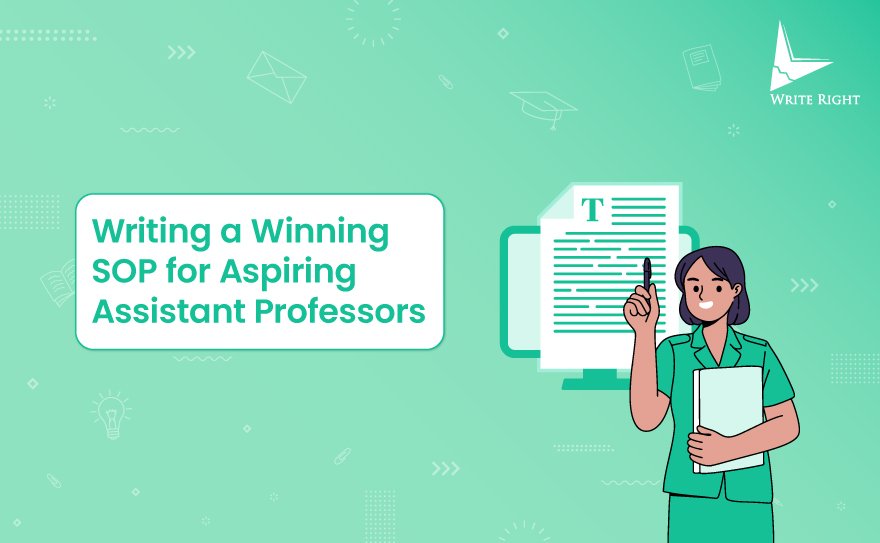Starting your career as an assistant professor is a significant step in academia, and writing a compelling Statement of Purpose (SOP) is a crucial part of the journey in 2025.
Your SOP is more than just a document; it’s your chance to show the hiring committee who you are beyond your resume. It’s where you connect your experiences, goals, and passion for teaching and research, all while demonstrating why you’re the right fit for the position.
Think of it like this: your SOP is your voice in a crowded room. It’s not just about listing accomplishments—it’s about telling your unique story, showing what makes you the perfect candidate to shape the future of education. Let’s break down how to write an SOP that stands out, engages the reader, and increases your chances of landing that dream job.
A Generic SOP Can Cost You a Prestigious Assistant Professor Position
You’ve spent years building your expertise—don’t let a weak SOP hold you back. Committees want more than qualifications; they seek passion, vision, and a clear academic trajectory. At Write Right, we don’t just write SOPs—we craft compelling academic narratives that highlight your research, teaching philosophy, and career goals. Our expertise ensures your SOP resonates with selection panels and strengthens your application.
Your dream position won’t wait—let’s create an SOP that demands attention! Contact Us
Step-by-Step Guide to Writing Your SOP For Assistant Professor
1. Reflect and Plan
Before you start writing, think deeply about your journey. Consider what the hiring committee is looking for and how you can align your story with their values. Reflect on your unique experiences that set you apart from other candidates.
2. Craft Your Narrative
Start by outlining your academic background. Use concrete examples to back up your claims. Highlight any teaching methods you’ve developed or research projects that have had an impact.
3. Structure Your SOP
- Introduction: Open with an engaging anecdote or pivotal moment in your academic journey.
- Body: Share your educational background, teaching experience, and research interests.
- Conclusion: Look to the future. Discuss how you plan to contribute to the department and academia as a whole.
Assistant professor roles are competitive—stand out with a powerful SOP! [Contact Now!]
4. Proof and Polish
Review your SOP multiple times. Make sure it’s clear, concise, and error-free. Consider asking a mentor or colleague to read it for feedback.
What Is An SOP?
When you think about the academic world, a Statement of Purpose (SOP) is a key document that aspiring assistant professors need to master. It’s a narrative that outlines your academic journey, your professional goals, and how you plan to achieve them. The SOP is your chance to tell your story, to show how your experiences have shaped you, and to share your vision for the future.
For assistant professors, the SOP is a strategic tool in the job application process. It’s where you articulate your teaching philosophy, your research interests, and how you plan to contribute to the institution and the wider academic community. Believe it or not, this document can make or break your chances of securing a position.
Every day you wait is a lost opportunity—Let’s get started with your SOP NOW!
Statistics suggest that candidates with a strong, clear SOP are more likely to catch the attention of hiring committees. It’s about making a connection, showing that you’re more than just a list of qualifications. A well-crafted SOP demonstrates your ability to think critically, to communicate effectively, and to implement your ideas in a real-world academic setting.
Your SOP should reflect who you are as an academic and as a person. It should give a glimpse into your potential as a future leader in education. Remember, it’s not just about what you’ve done, but also about what you plan to do and how you’ll execute those plans. That’s what makes an SOP not just good, but truly compelling.
Why is a Statement of Purpose for Assistant Professor important?
A Statement of Purpose (SOP) is an opportunity to present a compelling story that resonates with the values and vision of the institution you aspire to join.
Here, you lay down the foundation of your future, painting a picture of the educator and researcher you hope to become. It’s about showing how you plan to execute your ideas and implement strategies that will enrich the academic community.
A strong SOP is your ally, ensuring that your first impression is not just memorable but truly impactful. To help you write an SOP that will truly impress the admissions committee, we’ve put together a step-by-step strategy.
Read till the end for bonus tips from our expert SOP writers.
Get an SOP that speaks volumes about your academic brilliance! [Start Now!]
Key Tips For Writing a Winning SOP
- Personal Academic Journey & Motivations
Begin with the story of your academic journey. What inspired you to pursue this career path? Share the challenges you’ve overcome and the motivations that drive you forward. - Teaching Philosophy & Experience
Show your commitment to teaching. Outline your beliefs about education, how you approach engaging students, and provide examples of your teaching experience. - Research Interests & Accomplishments
Discuss your research. Highlight key projects, accomplishments, and what excites you about your field. Show how your research fits into the bigger picture of academia. - Vision for Future Research & Contributions
Look ahead. What’s your long-term academic plan? How do you envision contributing to the institution and the wider academic community? - What to Include & What to Avoid
Make sure to focus on your unique experiences. Avoid generic statements and instead, reflect on personal motivations and authenticity. Make it memorable by being genuine and enthusiastic.
Final Thoughts
Writing a compelling SOP is about more than just ticking boxes. It’s your opportunity to showcase your passion for academia, your dedication to teaching, and your drive for research.
With the right mix of personal narrative and professional accomplishments, your SOP can be the bridge that connects you to your future as an assistant professor. So, take your time, reflect on your journey, and craft a document that truly represents you.
FAQs About Writing an SOP for an Assistant Professor Role
- What is the purpose of a Statement of Purpose?
A Statement of Purpose (SOP) provides a personal narrative that highlights your academic journey, teaching philosophy, and research interests. It shows the committee why you’re the best fit for the position. - How long should my SOP be?
Typically, an SOP should be about 1-2 pages long, depending on the institution’s guidelines. Keep it concise but informative, avoiding unnecessary details. - What should I include in my teaching philosophy?
Your teaching philosophy should reflect your approach to education, how you engage students, and the methods you use in the classroom. Provide specific examples to support your beliefs. - How can I make my SOP stand out?
Focus on telling your unique story. Avoid clichés and generic statements. Be specific about your experiences and aspirations, and show how they align with the institution’s values. - Is it necessary to mention my research interests?
Yes, research interests are a key part of your SOP. Highlight your past research accomplishments and how you plan to contribute to future academic developments. - Should I tailor my SOP for each application?
Absolutely. Each institution has its own values and strengths, so make sure your SOP reflects how you can contribute specifically to their program. - Can I use the same SOP for multiple applications?
While the core of your SOP may stay the same, it’s important to customize it for each institution. Tailor it to reflect their unique values and how your goals align with their academic community.





